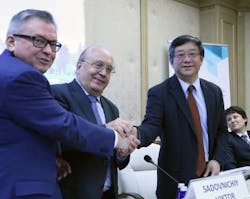Terahertz photonics consortium formed by international organizations
(FIGURE: Members of the newly formed International Consortium of THz Photonics and Optoelectronics met in Moscow.)
The International Consortium of THz Photonics and Optoelectronics was established on December 17, in Moscow, by 71 partners from 15 countries. A memorandum of understanding (MOU) was signed by the parties, represented at the inagural meeting by Vladislav Panchenko, President of Russian Foundation of Basic Research; Victor Antonovich Sadovnichy, Rector of Lomonosov Moscow State University, and X.-C. Zhang, Director of The Institute of Optics at the University of Rochester.
The MOU outlined the intent by the participants to further relations among them to implement international scientific, technological, and educational cooperation related to the properties and possible applications of terahertz (THz) photonics and optoelectronics. The paticipants agreed to establish long-term partnerships and take concerted actions for joint fundamental and applied research on topics of mutual interest.
Among the main goals of the consortium is cooperation in developing a long-term strategy and implementing specific actions aimed at scientific cooperation and coordination of R&D, fostering improved communication and consultation among the members, and assisting in the development of educational programs and publications.
Dr. Alexander Shkurinov from M.V.Lomonosov Moscow State University was elected as Secretary of the Consortium. For further information about the Consortium or becoming a member, please contact him at the Department of Physics and International Laser Center: [email protected].
(FIGURE: Shaking hands on the newly formed International Consortium of THz Photonics and Optoelectronics are, left to right, Vladislav Panchenko, President of Russian Foundation of Basic Research; Victor Antonovich Sadovnichy, Rector of Lomonosov Moscow State University, and X.-C. Zhang, Director of The Institute of Optics at the University of Rochester.)

Conard Holton
Conard Holton has 25 years of science and technology editing and writing experience. He was formerly a staff member and consultant for government agencies such as the New York State Energy Research and Development Authority and the International Atomic Energy Agency, and engineering companies such as Bechtel. He joined Laser Focus World in 1997 as senior editor, becoming editor in chief of WDM Solutions, which he founded in 1999. In 2003 he joined Vision Systems Design as editor in chief, while continuing as contributing editor at Laser Focus World. Conard became editor in chief of Laser Focus World in August 2011, a role in which he served through August 2018. He then served as Editor at Large for Laser Focus World and Co-Chair of the Lasers & Photonics Marketplace Seminar from August 2018 through January 2022. He received his B.A. from the University of Pennsylvania, with additional studies at the Colorado School of Mines and Medill School of Journalism at Northwestern University.
